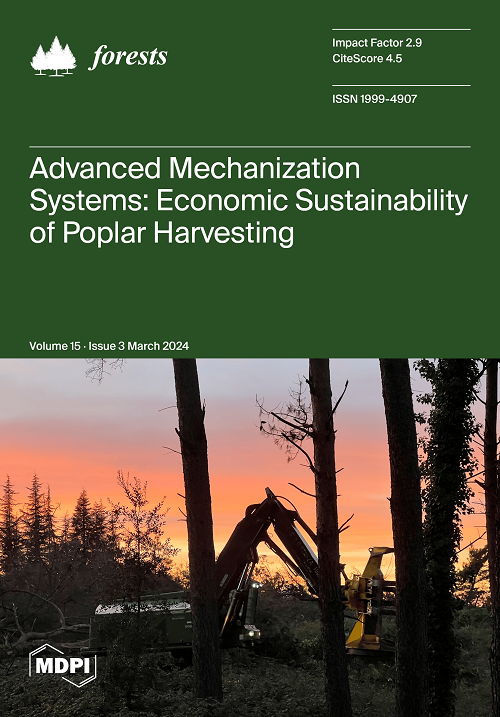加拿大东部严重退化地块上四种早生树种的第一年死亡率受地块整备处理因子的影响
IF 2.5
2区 农林科学
Q1 FORESTRY
引用次数: 0
摘要
由于气温高、太阳辐射强、风速大、气温变化剧烈、土壤水分和养分含量低等原因,矿区和垃圾堆放场等缺乏土壤的贫瘠、受严重干扰的场地给生态服务恢复带来了严峻挑战。我们使用三种场地准备处理方法进行了生态恢复实验。在荒芜了 25 年的场地上,对秸秆(S)、粉碎机(MC)和粗木屑(CWD)进行了场地、无场地准备 2 × 2 × 2 因式评估,包括对照处理。此外,还考察了四种早期演替物种:白桦(WB,Betula papyrifera Marsh)、灰桦(GB,Betula populifolia Marsh)、绿赤杨(GA,Alnus viridis Vill.死亡率在三个时间段后进行测量,分别是 2021 年夏季相关死亡率、冬季相关死亡率和霜冻死亡率(2022 年春季)。与夏季相关的死亡率主要受 S 处理(死亡率降低)及其相互作用的影响。秸秆的保湿能力强烈表明,它能减轻与夏季干旱相关的死亡率。S 相互作用不是等级变化,而是幅度效应。物种 × 稻草交互作用表明,SA 的影响程度差异最大,在 NS 和 S 处理中,夏季相关死亡率分别为 25% 和 3.6%。SA是亲水性物种,占夏季相关总死亡率的近一半,存在强烈的物种效应和物种交互作用。全部场地准备处理组合的夏季死亡率最低,仅为 1%。与冬季相关的死亡率仅占样本总量的 1.9%,而且没有物种效应或相互作用,但与其他结果相反,由于在过期幼苗上发现真菌,S 是导致死亡的主要原因。就冻胀死亡而言,S 处理显然有效,S 和 NS 的总死亡率分别为 1.2% 和 20.7%。单独使用 MC 产生的负面影响最大,霜疫病死亡率为 46.9%;但与 S 或 CWD 合用时,死亡率大幅下降。霜冻病没有物种交互作用,只有物种效应,其中南澳大利亚的死亡率最高。在第一年中,仅 MC 和对照组的死亡率最高,一年后分别为 60% 和 38%。总体而言,一年的死亡率显示,SA 降低了 27% 的死亡率,CWD 降低了 19%,而 MC 增加了约 4% 的死亡率。如果以任何方式组合处理,死亡率都会显著下降,显示出叠加效应,三组合处理的一年死亡率最低,仅为 3.1%。秸秆的效果最强,它既能有效阻止水分蒸发,在干燥条件下为土壤提供多达 10% 的水分,又能提供有效的隔热层,大大降低了冻胀的死亡率。即使是 WB、GB、GA 和 SA 等早生树种也需要进行场地准备处理,才能在长期贫瘠的土地上生长并在第一年存活下来。本文章由计算机程序翻译,如有差异,请以英文原文为准。
First-Year Mortality of Four Early-Successional Species on Severely Degraded Sites in Eastern Canada as Influenced by a Factorial of Site Preparation Treatments
Barren, severely disturbed sites lacking soil, such as mine sites and waste deposit sites, present severe challenges to ecological service restoration because of high temperatures, solar radiation, and wind speeds; extreme temperature changes; and low soil moisture and nutrient availability. An ecological restoration experiment using three site preparation treatments was conducted. Straw (S), Meri-Crusher (MC), and coarse woody debris (CWD) were assessed in a site, no site preparation 2 × 2 × 2 factorial, including a control treatment, on sites barren for 25 years. In addition, four early-successional species: white birch (WB, Betula papyrifera Marsh), gray birch (GB, Betula populifolia Marsh), green alder (GA, Alnus viridis Vill. ssp. crispa Ait) and speckled alder (SA, Alnus incana L. ssp. rugosa Du Roi), were examined for mortality. Mortality was measured after three time periods, summer-related 2021, winter-related, and frost heave mortality (spring 2022). Summer-related mortality was predominantly influenced by S treatments (reduced mortality) and their interactions. Straw’s ability to retain moisture strongly suggests it mitigated summer-related drought mortality. S interactions were not rank changes but magnitude effects. The species × straw interaction showed that SA had the greatest magnitude difference, with 25% and 3.6% summer-related mortality for NS and S treatments, respectively. SA, a hydrophilic species, accounted for nearly half the total summer-related mortality, and there were strong species effects and species interactions. The full combination of site preparation treatments had the lowest summer-related mortality, at 1%. Winter-related mortality only affected 1.9% of the total sample size, and there were no species effects or interactions, but contrary to other results, S was the leading cause of mortality due to fungal presence found on expired seedlings. For frost heave mortality, it was clear that the S treatment was effective, with 1.2% and 20.7% overall mortality for S and NS, respectively. MC alone had the greatest negative effect, with 46.9% frost heave mortality; however, when interacting with S or CWD, the mortality decreased substantially. Frost heave had no species interactions and only a species effect, with SA having the greatest mortality. Over the first full year, MC alone and control had the greatest mortality, with 60% and 38%, respectively, after one year. Overall, one-year mortality showed S reduced mortality by 27% and CWD by 19%, while MC increased mortality by approximately 4%. When treatments were combined in any way, mortality dropped significantly, showing an additive effect, with the three-combination treatment resulting in the lowest one-year mortality, of only 3.1%. Straw provided the strongest effect, both as an effective barrier to moisture evaporation, providing up to 10% more soil moisture under dry conditions and provided an effective thermal barrier that substantially reduced the frost heave mortality. Even early-successional species such as WB, GB, GA, and SA need site preparation treatments to establish and survive the first year on long-term barren lands.
求助全文
通过发布文献求助,成功后即可免费获取论文全文。
去求助
来源期刊

Forests
FORESTRY-
CiteScore
4.40
自引率
17.20%
发文量
1823
审稿时长
19.02 days
期刊介绍:
Forests (ISSN 1999-4907) is an international and cross-disciplinary scholarly journal of forestry and forest ecology. It publishes research papers, short communications and review papers. There is no restriction on the length of the papers. Our aim is to encourage scientists to publish their experimental and theoretical research in as much detail as possible. Full experimental and/or methodical details must be provided for research articles.
 求助内容:
求助内容: 应助结果提醒方式:
应助结果提醒方式:


